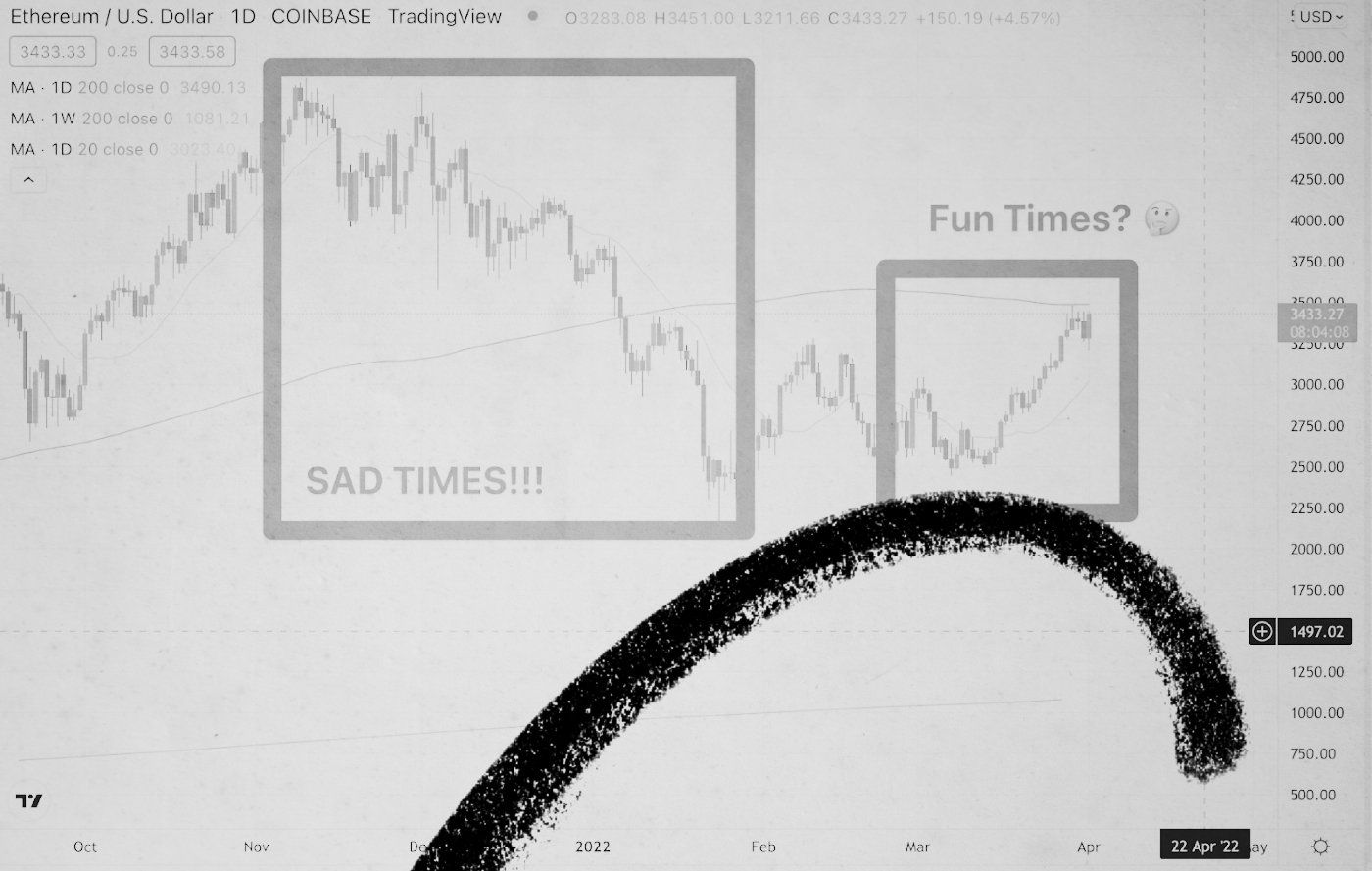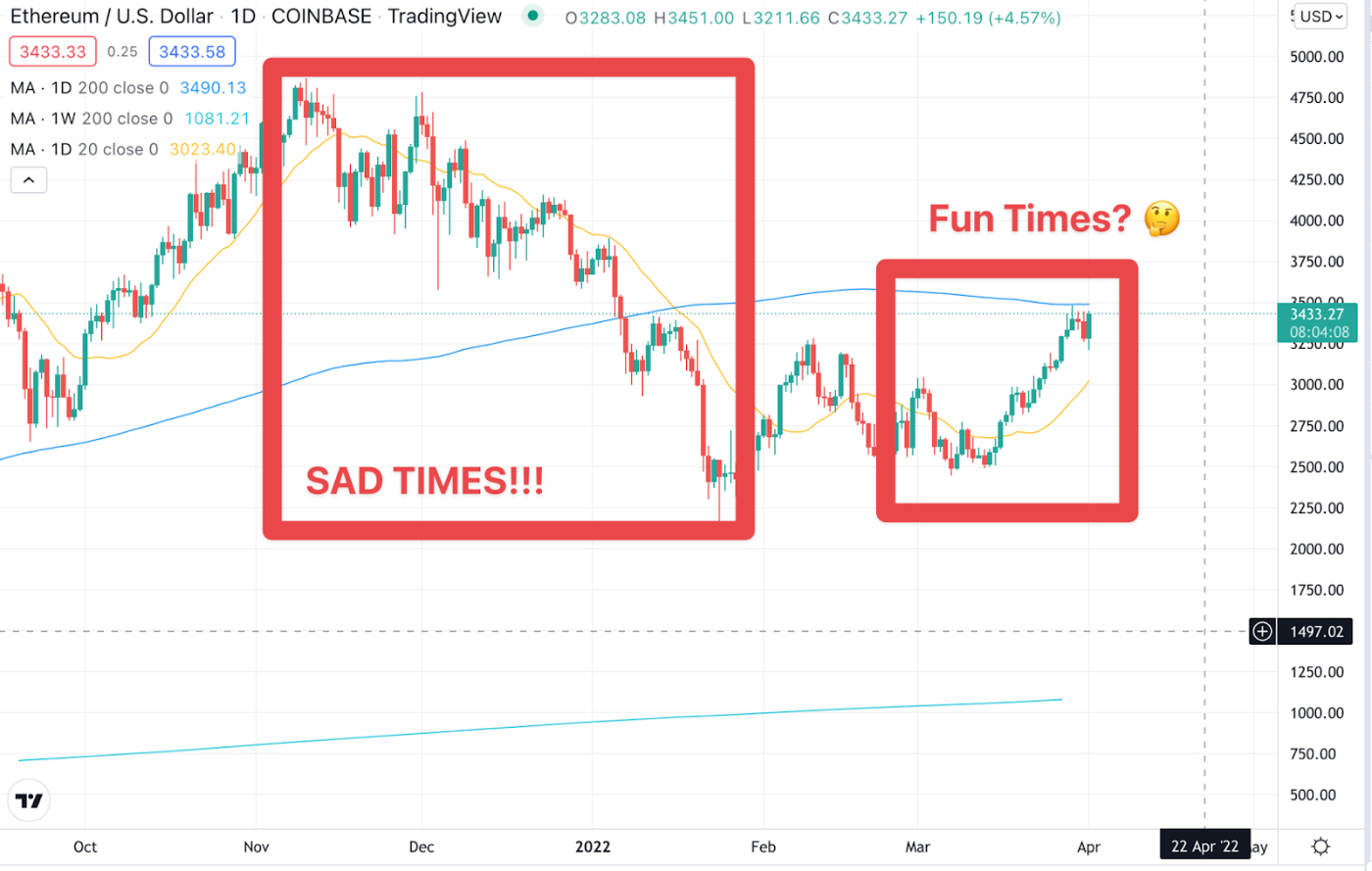
You can’t predict what the market will do, but since it feels like we’re entering the Fun Times in crypto again, let’s be responsible and think about selling.
This is something I’ve done a poor job of historically. I rode the high from September through November and took nothing off the table. Whoops.
So I spent more time thinking about how and when to sell in the last couple of months. I don’t have all the answers, but here’s how I’m thinking about it.
When you buy anything in crypto, there should be three times you sell it:
- When one of your ratios breaks
- When it hits your price target(s)
- When the “money pile” feels off
Let’s start with ratios.
Selling When Your Ratios Break
There are two high level ratios you want to keep in mind with crypto trading:
- Your crypto to net worth ratio
- Your in-crypto ratios
If either of these get broken outside your acceptable ranges, then you need to think about selling.
Your Crypto to Net Worth Ratio
The first is your crypto allocation as a portion of your total net worth. Do you want 10% of your net worth in crypto? 50%? 90%? I’m not going to tell you what this number should be, you just need to pick a number and stick to it.
I’ve settled on 50% as my allocation for while I’m working in the industry. This is not financial advice! That’s just what works for me and my financial situation. If I retire to a log cabin to write full time I might trim that down, but for now, 50% feels fine.
You need to know what this number is for you and revisit it occasionally so you can rebalance in and out of crypto. When your crypto percentage runs too high, it’s time to take money out of crypto. When it’s low, maybe you want to put more back in.
I currently have ~75% of my net worth in crypto, which is way above my 50% target. So even though we’re not at all-time highs or in the total exuberance phase of the cycle, I want to start rebalancing money away from crypto.
For me that means I have to sell some, but for you it could mean just stopping buying in favor of other things. Typically selling is less advantageous from a tax perspective than just stopping buying, but sometimes you have to sell things when your portfolio gets really out of balance.
The most important part of this ratio though is honoring it. It really pains me to take money off the table while it feels like we’re going into a bull run. But if that’s what the rules say, I have to follow them, since I know I can be a stupid monkey who gets carried away by FOMO and holds too long.
But what do you sell? That brings us to the next ratio to consider: your in-crypto ratio.
Your In-Crypto Ratio
Your in-crypto ratio is how you want your crypto holdings to be split among various asset classes.
Again, there’s no science here. Maybe you want a lot of NFTs. Maybe you want a lot of DeFi. Maybe you just want to hold the major blue chips. It’s totally up to you. My focuses are:
- ETH
- DeFi
- Alternative non-EVM L1s with DeFi ecosystems
I have some NFTs but I don’t really count them. I’m also not counting my tokens from Crypto Raiders or other projects I’m consulting on since those have their own set of rules. As an investor, I’m interested in these three areas since they’re the areas I know best.
My current target ratios are:
- ETH: 65%
- DeFi: 20%
- Alt L1s: 15%
So if my DeFi stack gets too big, then I need to rotate it into ETH or L1 plays. If my ETH stack is too large, it’s time to buy more DeFi and L1s.
The most important part of this though is that I index my crypto portfolio against ETH, not against USD. I’m not as interested in how an asset has appreciated in dollar terms—I care more about how it’s done in ETH terms.
My long term buy-and-hold DeFi assets I’m fine with not outperforming, or even slightly lagging ETH, if they provide good cash flows. Convex is a good example of this. It doesn’t need to completely keep up with ETH since it pays a nearly 50% dividend via bribes.
When the DeFi or Alt L1 ratio breaks though, then the question is: what do I sell? That will usually depend on my purchase prices, price targets, and how much of a long term hold I feel like it will be.
Which brings us to our second set of selling criteria: price targets.
Selling When Your Price Targets Hit
Certain investments you intend to hold for an indefinitely long time. The bulk of my ETH, for example, I have no intention of selling in the near term regardless of what price it hits. I’d only consider it if that were the only way to resolve my crypto to net worth ratio.
But other investments might be shorter term, or you might expect to have shorter term volatility that you want to capitalize on. You can still believe in them long term, but if they have a sudden run up, having price targets you’ll use to force yourself to sell can help remind yourself to take some profits.
When I wrote about JonesDAO I started buying because I felt like it was nearing the bottom of its post-launch drop. I started buying in the $5-7 range, for an average entry price around $5.80.
While I intend to hold it long-term assuming they keep delivering on their roadmap, I also plan to sell roughly half of my share once it goes up 2x against ETH.
This is a simple heuristic for setting price targets that I picked up from a friend. If you want to at least make sure your principal is covered, pick a multiple of the price you buy in at, and sell one divided by that multiple once it hits that price.
So if you wait for a 2x, you have to sell 1/2. If you wait for a 3x, you only have to sell 1/3. 4x, and you sell 1/4. The more bullish you are, the less you have to sell to cover your initial investment, but also the more risk you take on.
I like rules like this since after that, you’re playing with house money. You could sell at any price after this and it’s all profit.
It also forces me to ask whether I think an asset can appreciate compared to ETH. Most assets in crypto are highly correlated and move together. And while it’s boring, you’re often better off just holding ETH or BTC since other assets will often only move within a small range of their prices. So if I’m going to buy something besides ETH, I need to believe it will either appreciate at least 2-3x against ETH, or cash flow a good amount of yield while tracking ETH’s price.
This is also why I track these price movements in ETH terms, not dollar terms. My base case within my crypto portfolio is holding more ETH, so if an asset appreciated in dollar terms but dropped in ETH terms, it was a bad investment. It could also appreciate in ETH terms while dropping in dollar terms, which would make it a good investment!
If you believe an asset will appreciate that much against your base case, the hardest part will be selling when it’s taking off. That’s why these price target rules are so helpful. They give you a clear spot where you need to re-evaluate the size of your holdings and take some risk off the table.
Selling When the Money Pile Feels Too Big
The last tool for evaluating when to sell is the least scientific, but sometimes the most helpful. I call it the “Money Pile” question.
First, you get a rough sense of where all your money is. Both out of crypto using something like Tiller or Kubera, and in crypto using tools like Zapper, Zerion, or DeBank.
Then, you imagine it’s all sitting in a giant pile in front of you. It’s not invested in anything. It’s just a pile of cash.
If you had all that cash in front of you, would you put it in all the same places it’s in right now?
Forget about the ratios and other mathematical stuff from earlier. Would you put this money in all the same places? You will probably feel comfortable reallocating it in some areas, but in other areas you might think twice.
What I find this exercise particularly helpful for is recognizing areas where I might be taking on too much risk, and where I might be committed to some sunk cost from before.
If you have an investment that’s done poorly but that you’re hoping will turn around, would you put money back in it now? If you have some investments that have done exceptionally well, would you put their full current value back into them now? Or would you put some funds elsewhere?
Sometimes the mathematical, ratio based allocations aren’t the best approach. Your gut has a good intuition about where your money should be, and it might provide the bit of risk aversion you need to take some profits.
On a higher level this could also be how you set your ratios from the first section. Would you split your money pile into the same high-level buckets if it were all sitting in cash in front of you? Within crypto, would you allocate that money pile the same way if it were all in ETH or BTC or whatever you denominate it in?
Your process doesn’t have to be completely spreadsheet driven. Sometimes the spreadsheets are just how we justify what we emotionally want to do anyway, so trying to directly tap into that emotional side is often the more honest way to make decisions.
However you choose to make these decisions, the most important thing is having some process for making them.
Otherwise it’s too easy to get swept up in the euphoria and hold too long, take no profits, and end up regretting it later.
The Only Subscription
You Need to
Stay at the
Edge of AI
The essential toolkit for those shaping the future
"This might be the best value you
can get from an AI subscription."
- Jay S.
Join 100,000+ leaders, builders, and innovators

Email address
Already have an account? Sign in
What is included in a subscription?
Daily insights from AI pioneers + early access to powerful AI tools








Comments
Don't have an account? Sign up!
Thanks for the insight on your process Nat! I'm curious - have you have written about how you came up with your crypto to net worth ratio anywhere? Maybe you just picked a number that you felt comfortable with, but I also wouldn't be surprised if you have a process behind that number that would be interesting to hear about :).